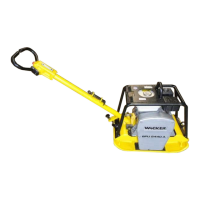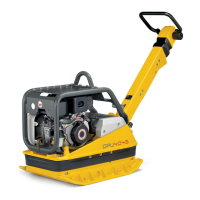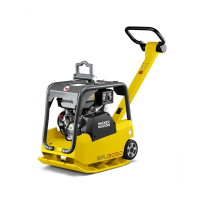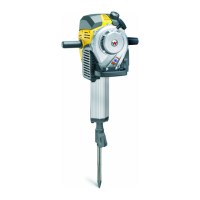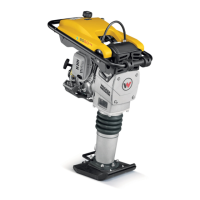General Information BPU 2440/2950 Repair
wc_tx000264gb.fm 16
3.9 Directional and Speed Control
See Graphic: wc_gr001431
The control lever (a) operates a hydraulically actuated piston which
connects to the sleeve gear inside the exciter. As the piston moves in
and out, the sleeve gear rotates, changing the position of the eccentric
weights (c) inside the exciter. It is the position of the weights inside the
exciter that determines the direction of travel.
1. Neutral: With the machine running and no control pressure applied,
the eccentric weights spin in phase and apply force in either the
upward or downward direction; each weight cancels any directional
force produced by the other. Due to the direction of rotation, the natural
tendency of the exciter is to shift into reverse. To prevent this from
happening, spring tension (c) in the handle is used to apply a constant
pressure on the control circuit. The value of the spring is such that it
balances the exciter assembly in its neutral position. In neutral the
machine will vibrate but will not travel forward or reverse.
2. Forward: When the control lever is moved forward, hydraulic
pressure pushes against the actuating piston inside the exciter. As the
piston moves in, the pin riding inside the helix of the sleeve gear
rotates the gear which in turn rotates the rear weights away from the
neutral position. The weights now rotate out of phase with each other.
While the forces of one set of weights lift the plate the forces from the
other set propel it forward. The farther the weights are shifted, the
faster the travel speed.
3. Reverse: When the control handle is released, the sleeve gear,
piston, and weights will automatically slip back into their neutral
position. If the control handle is pulled back past neutral, they continue
to slip until the piston reaches the end of its stroke and the weights
have shifted a full 90° in the opposite direction. In this position, the
plate will travel in reverse.
Speed: Top speed is achieved when the exciter weights are rotated a
full 90° in relation to each other. This occurs when the control lever is
shifted as far as possible in the forward or reverse direction.
Intermediate speeds are possible by partially shifting the control lever,
allowing the weights to assume a position somewhere between 0° and
90°.

